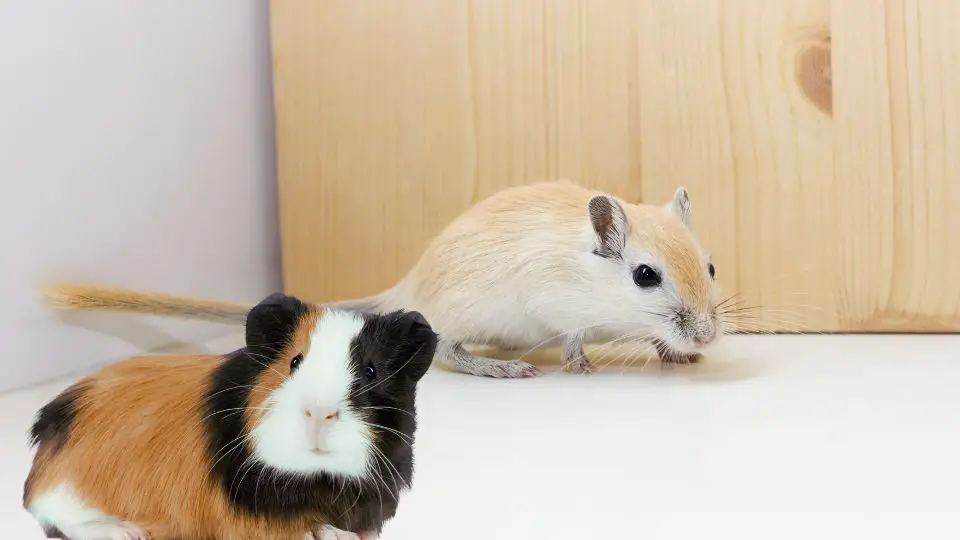Taming a gerbil can be a rewarding and fulfilling experience, but it requires time, patience, and understanding.
Each gerbil is unique and may require different approaches to build trust and form a bond.
In this article, we will explore effective strategies and techniques for taming your gerbil, helping them become comfortable with your presence and fostering a positive relationship.
Creating a Safe and Comfortable Environment
Creating a safe and comfortable environment for your gerbil not only ensures their physical well-being but also helps in building trust and reducing stress levels. By providing suitable hiding spots and enriching activities, your gerbil will have opportunities to feel secure and engage in natural behaviors. Additionally, maintaining a quiet and calm atmosphere will allow them to adjust more easily and feel more at ease in their surroundings.
How to provide a suitable enclosure
- Choose a spacious and secure enclosure that allows your gerbil to move around comfortably.
- Opt for a cage with solid flooring to prevent any injuries or foot problems.
- Include plenty of hiding spots, such as tunnels, boxes, or igloos, where your gerbil can retreat to feel safe and secure.
- Add various types of enrichment, such as chew toys, exercise wheels, and climbing structures, to stimulate their natural behaviors and keep them mentally engaged.
- Make sure to select safe and gerbil-friendly materials for their bedding, such as aspen shavings or paper-based products, to provide a cozy and comfortable substrate.
Ensure a quiet and calm environment to minimize stress
- Gerbils are sensitive to noise and disturbances, so it’s important to place their enclosure in a quiet area of your home.
- Avoid placing their cage near loud appliances, TVs, or areas with high foot traffic.
- Minimize sudden noises and vibrations that could startle or stress your gerbil.
- Maintain a consistent daily routine, providing regular feeding and playtime at the same times each day.
- Limit handling and interactions during the initial stages of taming to allow your gerbil to become accustomed to their new environment.
Establishing Trust and Bonding
Building trust and forming a strong bond with your gerbil is a gradual process that requires patience and consistency. By taking the time to familiarize them with your presence and associating positive experiences, you can establish a trusting relationship. Here are some effective strategies to help you in this endeavor:
Spend time near the gerbil’s enclosure
You should spend time near the gerbil’s enclosure to familiarize them with your presence:
- Sit or stand near the gerbil’s enclosure for short periods each day, allowing them to become accustomed to your presence.
- Avoid sudden movements or loud noises that could startle them. Instead, adopt a calm and relaxed demeanor to create a peaceful atmosphere.
- Speak softly and gently to your gerbil, using a soothing tone to let them become familiar with the sound of your voice.
- You can read a book or engage in quiet activities near their enclosure to give them an opportunity to observe you.
Offer treats and speak softly
You should offer treats and speak softly to associate positive experiences with your presence:
- Begin by offering treats through the bars of the cage or from your hand, allowing the gerbil to approach and take the treat at their own pace.
- Gradually move on to hand-feeding treats, using small, bite-sized pieces that are safe for gerbils.
- While offering treats, speak softly and use a gentle tone, allowing your gerbil to associate your voice with positive experiences.
- Consistency is key. Offer treats and engage in gentle interactions regularly to reinforce positive associations.
Remember, trust and bonding take time and will vary depending on the individual gerbil’s personality and past experiences. Some gerbils may be more cautious or timid, requiring extra patience and understanding. Avoid rushing the process and always respect their boundaries.
Gradual Hand Taming
Taming a gerbil requires patience, gentle interactions, and a gradual approach. By following a step-by-step process, you can help your gerbil become more comfortable with your hand and eventually allow handling. Here’s how to implement gradual hand taming with your gerbil:
- Respect their space: Start by placing your hand near the gerbil’s enclosure, allowing them to become familiar with your presence. Avoid sudden movements or loud noises that may startle them. Spend time near their enclosure, speaking softly and offering treats to create positive associations.
- Let them approach you: Once your gerbil seems comfortable with your presence, extend your hand into the enclosure with your palm facing up. Allow the gerbil to approach and investigate your hand at their own pace. Avoid making any sudden movements or attempts to touch them.
- Sniffing and exploring: Your gerbil may begin sniffing and exploring your hand. This is a positive sign and shows their curiosity. Avoid pulling away or making sudden movements that may alarm them. Allow them to familiarize themselves with your scent and presence.
- Gradual touch: As your gerbil becomes more comfortable with your hand, you can attempt gentle touches. Start by lightly touching their back or side, using slow and gentle movements. Pay attention to their reaction and stop immediately if they seem agitated or stressed.
- Positive reinforcement: Throughout the process, offer small treats as a reward for positive interactions. This helps reinforce the association between your hand and pleasant experiences. Use a gentle and encouraging tone of voice to create a soothing atmosphere.
- Increase handling gradually: Once your gerbil becomes comfortable with gentle touches, you can gradually increase the duration and intensity of handling. Start by scooping them up with cupped hands, supporting their body and providing a secure environment. Always be gentle and avoid squeezing or restraining them tightly.
- Respect their boundaries: It’s essential to respect your gerbil’s boundaries and never force handling. Each gerbil has its own comfort level and may need more time to feel completely at ease. If your gerbil shows signs of stress or discomfort, back off and give them space.
Hand-Feeding and Positive Reinforcement
Hand-feeding and positive reinforcement are effective techniques for building trust and strengthening the bond between you and your gerbil. By offering treats from your hand and using a calm and soothing voice, you can create positive associations and enhance your gerbil’s comfort level.
Here’s how to implement hand-feeding and positive reinforcement with your gerbil:
- Choose appropriate treats: Select small, bite-sized treats that your gerbil enjoys. Gerbils have specific dietary needs, so choose treats that are safe and suitable for them. Nutritious options like small pieces of fruits, vegetables, or gerbil-specific treats are ideal.
- Start by offering treats near your hand: Begin by placing treats near your hand and allowing your gerbil to approach and take them at their own pace. Avoid making sudden movements or attempts to touch them during this stage. The goal is to create positive associations between your hand and tasty rewards.
- Gradually progress to hand-feeding: Once your gerbil is comfortable taking treats near your hand, you can begin hand-feeding. Extend your hand with a treat in your palm and let your gerbil approach and take it from your hand. Be patient and allow them to move at their own pace.
- Use a calm and soothing voice: During interactions, speak to your gerbil in a calm and soothing tone. Avoid loud or sudden noises that may startle them. Your gentle voice will help create a sense of security and relaxation for your gerbil.
- Offer treats as rewards for positive behaviors: Whenever your gerbil exhibits desired behaviors, such as approaching your hand or showing curiosity, offer a treat as a reward. This positive reinforcement helps reinforce their trust in you and encourages further interaction.
Gradually Increasing Handling
Gradually increasing handling is an effective method to build trust and confidence with your gerbil. By starting with brief periods of gentle handling and gradually increasing the duration and frequency of these sessions, you can help your gerbil become more comfortable and accustomed to being held.
Here’s how to implement gradually increasing handling with your gerbil:
- Start with brief handling sessions: Begin by scooping your gerbil into your hand for a short period of time. Keep the sessions brief, starting with just a few seconds and gradually increasing the duration over time. This allows your gerbil to get used to the sensation of being held without feeling overwhelmed.
- Use gentle and slow movements: When handling your gerbil, use gentle and slow movements to avoid startling or stressing them. Approach from the side or from below, supporting their body with your hand, and avoid squeezing or gripping them too tightly. Your gerbil should feel secure and comfortable in your hand.
- Pay attention to your gerbil’s body language: Observe your gerbil’s body language during handling sessions. If they show signs of stress or discomfort, such as trying to escape or becoming tense, it’s important to respect their boundaries and end the session. Gradually increase the duration of handling sessions only when your gerbil appears relaxed and at ease.
- Increase duration and frequency over time: As your gerbil becomes more comfortable with being handled, gradually increase the duration of the sessions. Aim for longer periods of gentle handling, always monitoring your gerbil’s response and adjusting accordingly. You can also increase the frequency of handling sessions, offering your gerbil more opportunities to get accustomed to being held.
- Respect your gerbil’s comfort level: It’s important to respect your gerbil’s comfort level throughout the process. If your gerbil shows signs of stress or discomfort, take a step back and give them more time to adjust before attempting further handling. Each gerbil has its own unique personality and tolerance for handling, so it’s important to adjust your approach accordingly.
Respect Boundaries and Individuality
Respecting boundaries and individuality is crucial when taming and interacting with your gerbil. Just like humans, gerbils have their own unique personalities and comfort levels. It’s important to pay attention to their body language and cues to determine their comfort level and respect their boundaries. Here’s how to promote a positive and comfortable environment for your gerbil:
- Observe body language: Gerbils communicate through their body language. Pay close attention to their posture, tail position, ear movements, and vocalizations. These cues can give you insights into their current state of comfort or discomfort. For example, flattened ears, a raised tail, or trying to escape your hand may indicate that your gerbil is feeling stressed or uncomfortable.
- Take cues from your gerbil: Each gerbil has its own preferences and comfort zones. Some gerbils may be more naturally sociable and open to interactions, while others may be more timid and prefer to observe from a distance. Take cues from your gerbil and let them set the pace. If they show signs of stress or discomfort, such as trying to escape or hiding, respect their boundaries and give them space.
- Avoid forcing interactions: Forcing interactions can lead to increased stress and hinder the bonding process. If your gerbil is not ready for handling or seems uncomfortable, avoid forcing them into situations that they are not ready for. Instead, focus on building trust and gradually introducing interactions at their own pace.
- Provide hiding spots and safe spaces: Gerbils feel more secure when they have access to hiding spots and safe spaces in their enclosure. These areas provide them with a sense of security and a retreat when they need some alone time. Ensure that your gerbil’s habitat has suitable hiding spots, such as tunnels, boxes, or small houses, where they can retreat to when they want to be alone.
Consistency and Patience
Taming a gerbil requires patience, time, and consistent efforts. Each gerbil is unique, and the process of building trust and forming a bond can vary from one gerbil to another. It’s essential to approach the taming process with consistency and patience to create a positive and trusting relationship. Here are some important points to consider:
- Be patient: Taming a gerbil is a gradual process that can take time. Some gerbils may feel comfortable and bond quickly, while others may require more time to trust and become fully tame. Be patient and understanding, respecting their individual pace and comfort levels.
- Set a routine: Establishing a consistent routine is important for taming your gerbil. Regularly spend time near their enclosure, speaking softly and offering treats. This helps them become familiar with your presence and associate positive experiences with you.
- Slow and gentle approach: When attempting to touch or handle your gerbil, use a slow and gentle approach. Move your hand slowly and avoid sudden movements that may startle them. Offer treats from your hand and let them come to you at their own pace. Respect their comfort level and do not force interactions if they show signs of stress or discomfort.
- Celebrate small victories: Taming a gerbil is a series of small victories. Celebrate and acknowledge even the smallest steps of progress. This could be a gerbil willingly taking a treat from your hand, exploring their environment in your presence, or allowing brief periods of handling. Each positive interaction builds trust and strengthens the bond between you and your gerbil.
- Consistency is key: Consistency in your interactions and approach is crucial for taming your gerbil. Dedicate regular time each day for taming sessions, providing treats, and speaking softly to your gerbil. Consistency helps establish trust and reinforces positive associations with your presence.
- Respect their limits: Pay close attention to your gerbil’s body language and cues to understand their comfort level. If they show signs of stress or try to avoid interaction, respect their limits and give them space. Pushing them beyond their comfort zone can hinder the taming process and erode trust.
Conclusion
Taming a gerbil is a journey that requires consistency, patience, and respect for their individual needs and boundaries. By setting a routine, offering treats, and providing a calm and gentle approach, you can gradually build trust and form a strong bond with your gerbil.
Remember to celebrate small victories and progress, as each step brings you closer to a trusting and enjoyable relationship. With time and dedication, your efforts will be rewarded as you witness the transformation of a once-timid gerbil into a friendly and interactive companion. Enjoy the process and cherish the special connection you develop with your tamed gerbil.







